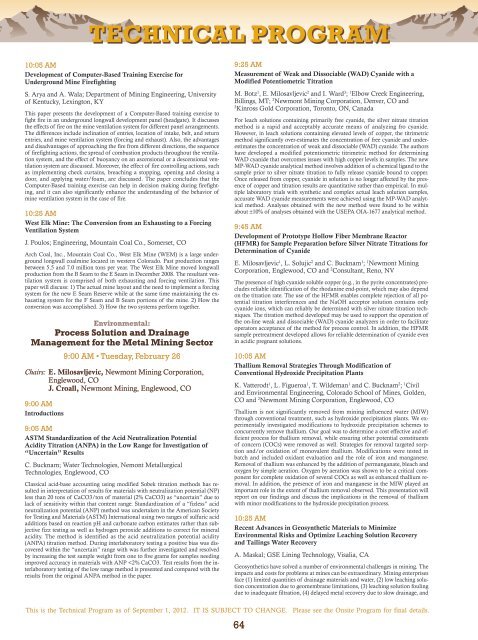Annual Meeting Preliminary Program - Full Brochure (PDF) - SME
Annual Meeting Preliminary Program - Full Brochure (PDF) - SME
Annual Meeting Preliminary Program - Full Brochure (PDF) - SME
Create successful ePaper yourself
Turn your PDF publications into a flip-book with our unique Google optimized e-Paper software.
TECHNICAL PROGRAM<br />
10:05 AM<br />
Development of Computer-Based Training Exercise for<br />
Underground Mine Firefighting<br />
S. Arya and A. Wala; Department of Mining Engineering, University<br />
of Kentucky, Lexington, KY<br />
This paper presents the development of a Computer-Based training exercise to<br />
fight fire in an underground longwall development panel (headgate). It discusses<br />
the effects of fire on the mine ventilation system for different panel arrangements.<br />
The differences include inclination of entries, location of intake, belt, and return<br />
entries, and mine ventilation system (forcing and exhaust). Also, the advantages<br />
and disadvantages of approaching the fire from different directions, the sequence<br />
of firefighting actions, the spread of combustion products throughout the ventilation<br />
system, and the effect of buoyancy on an ascensional or a descensional ventilation<br />
system are discussed. Moreover, the effect of fire controlling actions, such<br />
as implementing check curtains, breaching a stopping, opening and closing a<br />
door, and applying water/foam, are discussed. The paper concludes that the<br />
Computer-Based training exercise can help in decision making during firefighting,<br />
and it can also significantly enhance the understanding of the behavior of<br />
mine ventilation system in the case of fire.<br />
10:25 AM<br />
West Elk Mine: The Conversion from an Exhausting to a Forcing<br />
Ventilation System<br />
J. Poulos; Engineering, Mountain Coal Co., Somerset, CO<br />
Arch Coal, Inc., Mountain Coal Co., West Elk Mine (WEM) is a large underground<br />
longwall coalmine located in western Colorado. Past production ranges<br />
between 5.5 and 7.0 million tons per year. The West Elk Mine moved longwall<br />
production from the B Seam to the E Seam in December 2008. The resultant ventilation<br />
system is comprised of both exhausting and forcing ventilation. This<br />
paper will discuss: 1) The actual mine layout and the need to implement a forcing<br />
system for the new E Seam Reserve while at the same time maintaining the exhausting<br />
system for the F Seam and B Seam portions of the mine. 2) How the<br />
conversion was accomplished. 3) How the two systems perform together.<br />
environmental:<br />
Process Solution and drainage<br />
Management for the Metal Mining Sector<br />
9:00 AM • Tuesday, February 26<br />
chairs: E. Milosavljevic, Newmont Mining Corporation,<br />
Englewood, CO<br />
J. Croall, Newmont Mining, Englewood, CO<br />
9:00 AM<br />
Introductions<br />
9:05 AM<br />
ASTM Standardization of the Acid Neutralization Potential<br />
Acidity Titration (ANPA) in the Low Range for Investigation of<br />
“Uncertain” Results<br />
C. Bucknam; Water Technologies, Nemont Metallurgical<br />
Technologies, Englewood, CO<br />
Classical acid-base accounting using modified Sobek titration methods has resulted<br />
in interpretation of results for materials with neutralization potential (NP)<br />
less than 20 tons of CaCO3/ton of material (2% CaCO3) as “uncertain” due to<br />
lack of sensitivity within that content range. Standardization of a “fizless” acid<br />
neutralization potential (ANP) method was undertaken in the American Society<br />
for Testing and Materials (ASTM) International using two ranges of sulfuric acid<br />
additions based on reaction pH and carbonate carbon estimates rather than subjective<br />
fizz testing as well as hydrogen peroxide additions to correct for mineral<br />
acidity. The method is identified as the acid neutralization potential acidity<br />
(ANPA) titration method. During interlaboratory testing a positive bias was discovered<br />
within the “uncertain” range with was further investigated and resolved<br />
by increasing the test sample weight from one to five grams for samples needing<br />
improved accuracy in materials with ANP
















